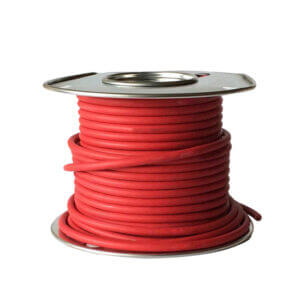What Battery Cable Should I Use?
Choosing the right battery cables is essential for ensuring your battery systems work safely and efficiently.

Understanding What is Battery Cable?
First, we need to understand what battery cables are. Generally speaking, a battery cable is a cable that connects batteries to your motor, inverter, or other machinery. Since the current that passes through the battery is DC (direct current), the cables used for batteries are usually single-core.
Key Factors to Consider
When selecting the right battery cable, several key factors need to be considered:
- Color
- Size
- Material
Cable Color (Positive and Negative)
Battery cables are generally single-core because the current through them is DC. However, it should be noted that batteries are divided into positive and negative terminals, so the corresponding battery cables need to be differentiated between positive one and negative one.
We usually use “+” to express the positive terminals, which you can find on batteries, usually in the form of a “+”. Usually, the positive battery cable is connected to the red color cable. Negative battery cables are represented by “-” and their cable color is black.
Important Note: Please be careful not to reverse the positive and negative terminals, as this may cause a short circuit and a safety accident.
Cable Size
After determining the construction of the cable, what we need to determine is the size of the battery cable. At this point, one of the concepts that we need to introduce is “resistance.”
Resistance is the amount of resistance that a conductor has to the current. When the resistance is higher, the current that can pass through it will be smaller, and the final electrical energy that will be transferred to the inverter, motor, or machinery will be smaller as well. The greater the resistance, the greater the resistance of the current in the circulation process will be greater, thus generating more heat. When the temperature exceeds the operating temperature of the cable insulation, it will often catch fire and cause a fire. As you can see, choosing a cable with the right resistance is crucial if you want your battery system to operate safely and properly.
Factors Affecting Resistance
The main factors that affect a cable’s resistance:
- Cable Length: Cable resistance increases as the length of the cable increases.
- Conductor Material: Aluminum conductors are much more resistive than copper conductors. This is why we advise our clients to use pure copper cables.
- Cable Size: Cable resistance increases as cable size decreases.
Current Table
| AWG | Cable Diameter (mm) | Cable Cross-section (mm²) | Maximum Current (A) for a Total Cable Length up to 5 Meters | Maximum Current (A) for a Total Cable Length up to 10 Meters | Maximum Current (A) for a Total Cable Length up to 15 Meters | Maximum Current (A) for a Total Cable Length up to 20 Meters |
|---|---|---|---|---|---|---|
| 18 | 0.98 | 0.75 | 2.3 | 1.1 | 0.8 | 0.6 |
| 16 | 1.38 | 1.5 | 4.5 | 2.3 | 1.5 | 1.1 |
| 14 | 1.78 | 2.5 | 7.5 | 3.8 | 2.5 | 1.9 |
| 12 | 2.26 | 4 | 12 | 6 | 4 | 3 |
| 10 | 2.76 | 6 | 18 | 9 | 6 | 5 |
| 8 | 3.57 | 10 | 30 | 15 | 10 | 8 |
| 6 | 4.51 | 16 | 48 | 24 | 16 | 12 |
| 4 | 5.64 | 25 | 75 | 38 | 25 | 19 |
| 2 | 6.68 | 35 | 105 | 53 | 35 | 26 |
| 1 | 7.98 | 50 | 150 | 75 | 50 | 38 |
| 2/0 | 9.44 | 70 | 210 | 105 | 70 | 53 |
| 3/0 | 11.00 | 95 | 285 | 143 | 95 | 71 |
| 4/0 | 12.36 | 120 | 360 | 180 | 120 | 90 |
Cable Sheath Material
For the cable sheath material, we have written a detailed post about choosing the suitable battery sheath material. Following is a simple table for reference:
| Cable Type | Sheath Material | Temperature Range | Bending Radius | Key Features | Recommended Use |
| SGT PVC Sheathed Battery Cable | PVC | -30°C to 75°C | 12xØ | Economical, general use | Most battery systems |
| STX XLPE Sheathed Battery Cable | XLPE | -40 °C to 125°C | 4xØ | Flame retardant, resistant to acids, lyes, gasoline, and diesel | Automotive and marine systems in confined spaces |
| SGX XLPO Sheathed Battery Cable | XLPO | -40 °C to 125°C | 5xØ | Excellent antiaging and mechanical properties | Critical battery connections in harsh environments |
| Silicone Rubber Sheathed Cable | Silicone Rubber | -40 °C to 200°C | 4xØ | High temperature resistance, excellent flexibility | Energy storage systems, connections between batteries and converter boxes |
| Welding Battery Cable | Rubber | -25°C to 85°C | 7xØ | Low cost, reasonable flexibility, oil resistant | Welding applications, limited flexibility but non-flame retardant |
Choosing the Correct Battery Cable
For the battery systems’ safety and efficiency, we always advise our customers to follow these suggestions:
- Use pure copper conductors
- Minimize cable length if possible
- Select the right cable size
- Silicone rubber XLPE is better than PVC sheath

Conclusion
In summary, I recommend pure copper conductor cables with the shortest possible distance from battery to battery and battery to equipment. As for the size of the cable, there is no need to pursue a larger size; the right size is sufficient because the price per meter of cable is not low. For the sheath material, Silicone Rubber or XLPE will be better.
FAQs
- What is the difference between positive and negative battery cables?
- Positive cables are usually red and marked with a “+”, while negative cables are black and marked with a “-“.
- How do I choose the right size battery cable?
- Consider the cable’s resistance, length, and conductor material. Use the provided current table for guidance.
- Why is pure copper recommended for battery cables?
- Pure copper has lower resistance compared to other materials, ensuring better conductivity and safety
- Do you offer a professional battery connection cable assembly service?
- Sure! KMCABLE offers professional battery solutions including battery cable and pre-assembled battery cable. Our experts are always glad to help you!

